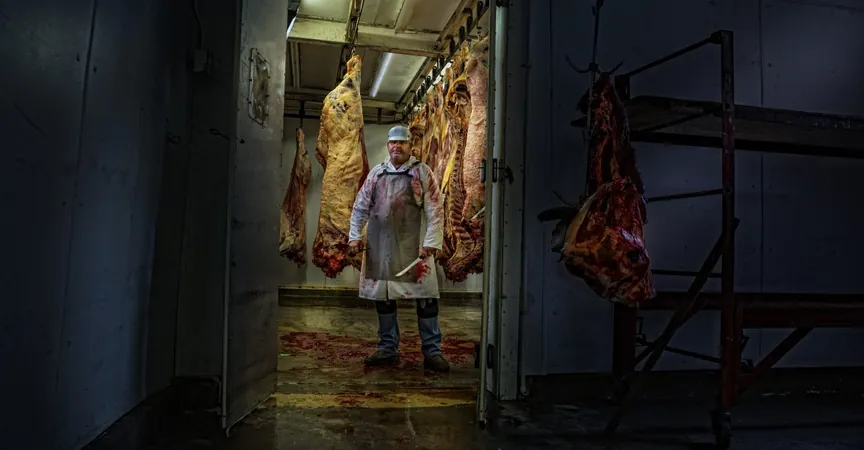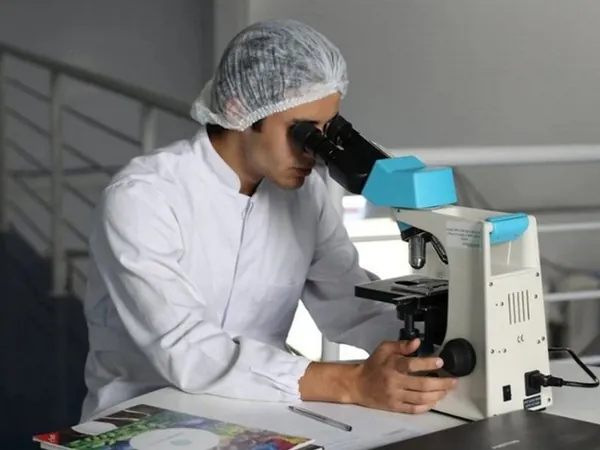
The Hidden Horror: Why Slaughterhouse Workers May Suffer More Than We Think
2025-06-04
Author: Mei
The Dark Reality Inside Slaughterhouses
In a startling revelation from the upcoming documentary "The Dying Trade," a former slaughterhouse worker named Tom shares a chilling account that continues to haunt him years later. He recounts the moment he was forced to skin a cow alive while she was giving birth—a grisly reminder of the brutal realities faced by many in the meat industry.
A Job That Desensitizes Humanity
Tom’s journey through various slaughterhouses in Europe from the late 1990s to the mid-2010s was fraught with trauma. Tasked with skinning animals that had been rendered unconscious, he often faced a horrifying scenario where cows remained conscious. He admits, 'You become a robot' in this environment—where the speed of production overrides humane treatment.
The Psychological Toll of Violence
To cope with the relentless horrors of his job, Tom turned to alcohol, drowning his sorrows from dusk till dawn, and experimented with psychedelics to escape his grim reality. He recalls fantasizing about being on vacation, anywhere but where he was physically present. However, his mind never quite left the slaughterhouse—he still experiences vivid nightmares and unsettling thoughts of violence.
Perpetration-Induced Traumatic Stress (PITS)
Tom identifies his struggles as a manifestation of Perpetration-Induced Traumatic Stress (PITS), a lesser-known traumatic response to being a perpetrator of violence rather than a victim. This phenomenon is increasingly recognized as many slaughterhouse workers battle anxiety, depression, and various mental health issues but often remain overlooked.
The Danger Behind the Steel Walls
While the physical hazards of working in slaughterhouses are well documented, the mental strain remains less understood, primarily due to a lack of comprehensive studies. Reports indicate soaring rates of anxiety and depression among workers, with increasing concerns as more slaughterhouses proliferate globally to meet rising meat consumption.
Societal Blindness to the Crisis
A specific issue highlighted by experts, including social psychologist Rachel MacNair, is that the public’s appetite for cheap meat perpetuates a cycle of trauma and retraining these workers in violence. It’s a grim reality that the demand for meat directly contributes to ongoing psychological distress among slaughterhouse employees.
Brutality Beyond the Killing Floor
It's not only the act of killing that leaves scars. Former inspector David Magna shares his mutual trauma from witnessing distressing scenes in the chicken slaughter industry, such as dead birds arriving in horrific conditions from extreme temperatures. Even for those who don’t wield the knife, the mental burden can be overwhelming.
The Untold Stories of Survivors
Both Tom and Magna illustrate a widespread crisis—where systemic exploitation traps workers, particularly marginalized communities, into cycles of violence and mental health struggles. Magna, who reported worsening physical conditions due to workplace hazards, now lives with PTSD and an awareness of the severe emotional toll this industry exacts on individuals.
Activism and Hope After Trauma
In response to their harrowing experiences, many former workers, including Magna, have embraced veganism and animal rights activism as a form of rehabilitation. They’re determined to shed light on the grim realities of the meat industry—advocating for better practices and support for those still entrapped by the system.
The Call for Change
As awareness grows, it becomes increasingly vital to recognize the human cost behind our meat consumption. From the chilling stories recounted in "The Dying Trade" to the broader implications of industry practices, the conversation must shift towards empathy and reform before more lives are irrevocably damaged.


 Brasil (PT)
Brasil (PT)
 Canada (EN)
Canada (EN)
 Chile (ES)
Chile (ES)
 Česko (CS)
Česko (CS)
 대한민국 (KO)
대한민국 (KO)
 España (ES)
España (ES)
 France (FR)
France (FR)
 Hong Kong (EN)
Hong Kong (EN)
 Italia (IT)
Italia (IT)
 日本 (JA)
日本 (JA)
 Magyarország (HU)
Magyarország (HU)
 Norge (NO)
Norge (NO)
 Polska (PL)
Polska (PL)
 Schweiz (DE)
Schweiz (DE)
 Singapore (EN)
Singapore (EN)
 Sverige (SV)
Sverige (SV)
 Suomi (FI)
Suomi (FI)
 Türkiye (TR)
Türkiye (TR)
 الإمارات العربية المتحدة (AR)
الإمارات العربية المتحدة (AR)